|
SPEX
Years Represented: 1993-1997
Class: Mid-size
Type: 5-door station wagon
Country: Japan ````````````````````````````````````` Host: GT1, 2, 3, 4, & 5
*Stats below are for a '93 Touring Wagon GT from GT2, and a '96 Touring Wagon GT-B from GT4 & 5
Price: 13,484 (GT2)
10,265
(GT4) 20,6xx (GT5)
Body Construction: unit steel
Length: 183.8", 184.25" (GT5) // Width: 66.7" // Height: 58.7"
Wheelbase: 103.5"
Overhang: @6 feet 6 inches,
6 feet 8 inches (GT5)
Track: 57.3" [F] 57.3" [R]
Ground Clearance: 6.3"
Weight: 3,064 lbs (Touring Wagon) 3,152 (GT-B)
Weight
Distribution: 53/47%
Layout: Front Engine / All Wheel Drive
Tires: 205/50R-16
F. Suspension: MacPherson struts/coils/
lwr. wishbones, anti-roll bar
R. Suspension: Chapman struts / trailing arms / coils / anti-roll bar
Brakes: Vented
Discs + ABS
The car in GT5 had oil change, but no engine rebuild
Engine: 2.0 liter DOHC Flat-4
Construction: aluminum block & heads
Tested HP: 266 @ 6,600 rpm (GT2)
275 @ 6,500 rpm (GT4) 272 @ 6,500 rpm (GT5)
Tested
Torque:
228 @ 5,500 rpm (GT2)
249 @ 5,000 rpm (GT4) 245 @ 5,000 rpm (GT5)
Lbs. per
HP: 11.5x (GT2), 11.46 (GT4), 11.58 (GT5)
HP per Liter: 136.8 (GT2), 137.9 (GT4), 136.4 (GT5)
Credits
per HP: 50.69 (GT2). 37.36, NA (GT5)
Aspiration: twin turbo Fuel System: sequential multi-point fuel inj. valves per cyl: 4 Compression: 8.0-9.0:1
(depends on year and model) Bore x Stroke: 3.62 x 2.95" GT2 Redline: 7,000 // RPM Limit: 8,000 GT4 Idle: 1,000
// Redline: 7,500 // RPM Limit: 8,000 Transmission: 5-speed manual Differential: open front, viscous center, limited-slip
rear
*Again, GT2's test was performed with a '93 Touring Wagon while GT4's was with the '96 GT-B (oil changed)
```````````````````````GT2``````````````````````````GT4``````
0-60 mph: 5.85 seconds 6.266 seconds
0-100
mph: 16.0 seconds 15.433 seconds
0-150 mph: no test
45.933 seconds
400 M: 14.924 @ 95 mph 14.893
@ 99 mph
1 KM: 26.574 @ 124 mph
26.504 @ 128 mph
Test Track: 1:44.493
2:26.485
100-zero mph: no test
3.700 seconds
Top Speed at Redline (GT2)
1st; 34 mph
2nd: 58 mph
3rd: 84 mph
4th: 112 mph
5th: 161.51
mph (7,700 rpm)
Top Speed at Redline (GT4)
1st: 38 mph
2nd: 65 mph
3rd: 95 mph
4th: 126 mph
5th: 160.34 mph @ 7,250 rpm
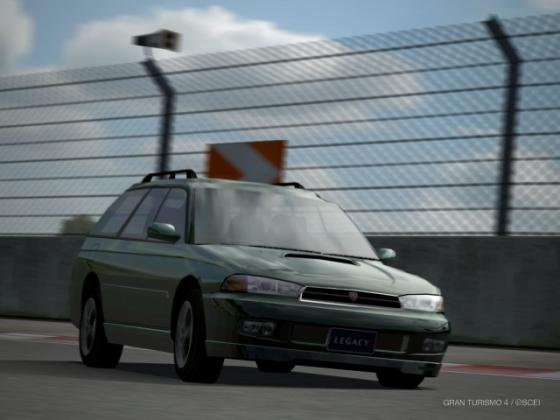
--------------------EXTERIOR-----------------
In Gran Turismo, the Legacy is represented as both wagon and
sedan, but this review is going to focus on just the second-generation Legacy wagons.
There are two basic models in GT1: the Touring Wagon and the GT-B.
The difference? Well the GT-B has about 30 more hp, but it also weighs about 100 pounds extra as well. In GT2, there
are four models. One of them is new, two are used, and the '96 GT-B can be bought used or won as a prize.
GT3? Hopefully you're not a fan of Subaru Legacy Wagons...there's only one here for racing, and (if we go
by the size of the engine, which is a 2.0 and not the later 2.5) it's not even from the 2000 model year.
GT4 and 5 have
several versions, but only the 1996 GT-B from earlier games can be had from the 2nd-generation, and these can only be found
as used cars. There may be more from games that aren't NTSC/North America though. The other Legacys in GT4 and 5 are
new cars which might get their own review some day, since they are 3rd-gen autos with bigger engines. They also
handle somewhat differently.
Overall in GT2, there are a lot more used Legacys (sedans and wagons) than
there are in other games; like I said, this game boasts the most variation. Used Legacy Wagons are a little less common in
GT4, but can usually be sought in a matter of game-weeks, if not days. In GT5, this game's sole GT-B has become rarer than
Lamborghinis, somehow. I know because it took me ages to find one.
The Legacy is tall when compared to many others in our games. It looks cumbersome, yet often handles
better than expected. One can race these wagons without any mods, and possibly still blow away competition in the beginning
levels of any GT game. Even though it has a higher center of gravity than typical, it is a very grippy car. The Legacy's
awesome suspension & tires make up for all the leaning and body-sway these cars exhibit. In GT1, the Legacy Wagon is amongst
the tallest of the tall at 58", being surpassed only by the 60" high Demio. That's about 10 to 15 inches taller
than your typical sports car! GT2 and 4 both have a slew of mini-vans, MPVs, and SUVs that surpass either the Legacy
or Demio in height, though.
When the Legacy was released in the early '90s, it pissed off some of Subaru's ‘Loyale’ customers...literally!
The Legacy's predecessor was named the Loyale, after all. The Loyale was a no-frills model with boxy styling
and what seemed to be two rats running on a wheel under the hood. In comparison, the Legacy is more polished, more stylish,
more powerful, more suburban-ish. It might even be
said that Subaru's Legacy and Forester were responsible for starting the whole crossover/SUV trend. Let's notice how
it's popular nowadays to have all-wheel drivetrains in cars which would not have had such parts in the past. During the
1950s into the '80s, rear-drive was most popular in wagons, until the Japanese began to change this to front-drive. Years
ago it was not common to find AWD or 4WD layouts under anything but jeeps and trucks. Well, Subaru changed
all that.
The Legacy Wagon is nowhere near perfect, but as we shall see, it actually is very capable
as a race-car at various tracks, in various games. So far as looks go, there are eight colors available to choose
from. Obviously if the wagon you're seeking is used, it might be harder to find in the color you desire. On the hood is
an air scoop which blatantly communicates that this is not your ordinary, everyday bread-and-butter wagon.
Weight
reductions should be among the first order of business when modifying a Leg Wagon for more advanced races, which
will help lessen their top-heavy nature. But it's interesting because these aren't super-heavy vehicles. Most early racing
(assuming it's at an easier level of competition) won't require any weight reductions. They only become necessary when
all else seems as if it's starting to fail.
So while moms and hippies alike enjoy using Legacys to get around
town--with an occasional trek to the soccer game or a weekend ski trip out in the woods, don't underestimate this car's potential
on the tracks.
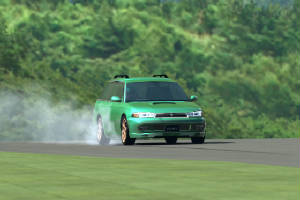
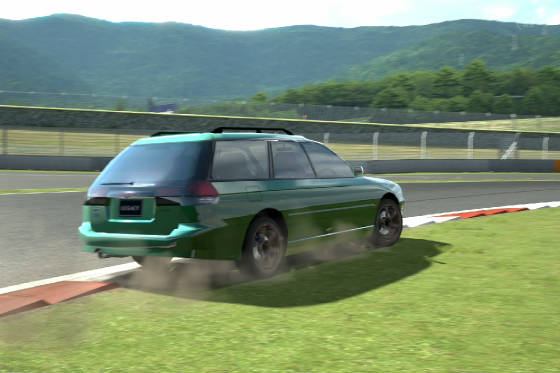
--------------ENGINE / DRIVETRAIN-----------
Good news in the engine department. ;)
A stock 2.0 liter
flat-4 Subaru engine can outrun any beginner-level competition, and will usually only need light modification
for intermediate races. Real-life Legacys were either twin-turbocharged or naturally-aspirated from the factory, but
we only get the turbos, which can be modified thru all four stages in GT1.
In GT2, there are
only three turbos available. Actually, for the '93 Touring Wagon, there are only two stages! Sports and
racing intercoolers are both on the STi aftermarket, as well. Only once you're getting deep in the game will you need to start
spending lots of money on the engine; it will be necessary to get the Legacy to compete at higher levels of GT racing,
but don't fret; it will be money well-spent. Top ratings would be as follows:
'93
Legacy Touring Wagon GT: 417
'96 Legacy GT-B: 454
'97 Legacy GT-B: 454
'98 Legacy GT-B: 516
The
'96 Touring Wagon GT-B in GT4 and 5 also only accepts 3 turbo stages, but can't make quite as much power as
found in earlier games, unfortunately. This could depend on how many miles are on the car, of course. But no worries;
there's still lots we can do with this car as well.
Unmodified, the Legacy will hit 60 mph from a standing start in around 6 seconds, which ain't bad for
a 4-wheel drive kid & grocery hauler. Depending on the game, zero to 60 can be taken anywhere from the high fives
to the low sixes. Quarter-miles and other such milestones can also be passed in competitive terms, as compared to
other modern sports cars. Take a sample of some of our game's other wagons and mini-vans (especially
in GT2, 4, and 5) and you'll see what I mean.
As mentioned, here we have a twin-turbo set up, rather
than a single. The 2nd turbo only kicks-in at higher revs, which helps combat turbo-lag, but this car still suffers from it
as more crap gets bolted under the hood. This is truest in GT1...not as much in later games. Also, acceleration is
amazing on the lower-end (below 100 mph) but starts to lag as speed builds, and the gearbox is shifted
into 4th. All Subies suffer from this due to their boxy styling, which inhibits air-flow, and their 5-speed gearboxes,
which cause the engine to eventually step outside of its best horsepower range at higher speeds.
Despite this, stock gearing can actually be perfect for many racing situations,
and STi's close-ratio boxes make things even better at certain tracks. Full-custom gears aren't ever an immediate need.
For me, anyways, but in some cases they do come in hand, especially as power gets raised. I believe there's a jump from
5 to 6 speeds for all games.
This car features Subaru's famous AWD system, which is really what makes any Subaru kick ass. The Legacy
will do great off-road if you're unlucky enough to find yourself making any unwanted argricultural expeditions. In fact, the
Subaru (more than any other Japanese car) can be driven over grass, sand, or curbs and will use these forays to its advantage.
With 160 mm (6.3") of ground clearance, this wagon has plenty of leeway over bumps of any kind, making its ride smooth
enough.
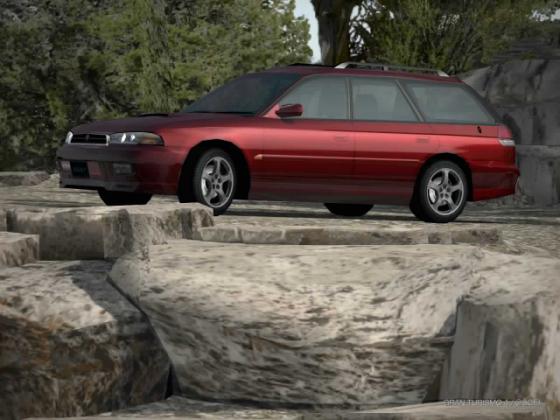
---------------------CHASSIS / HANDLING----------------
Like I mentioned earlier, some games feature Legacy wagons
with a "GT-B" designation, and some do not. What's the difference? Well the "B" stands for "Bilstein". Cars with the GT-B
name have genuine Bilstein struts installed, which is supposed to provide a firmer, slightly more competition-ready ride than
regular Touring Wagons.
In any case, the Legacy Wagon is rather tall. It's not really proportionate for racing (one might
think), yet in GT1 it handles well enough even before stabilizers are installed. It will need stabilizers in this game once the
the engine is being modified, though.
There are two reasons why the car's height doesn't become as much of a
factor as it should: (1) it's got a flat engine (rather than an upright one) which keeps its overall center of gravity low.
(2) All Subarus in our games feature a "symmetrical" all-wheel drive system. Simply, this means that the engine, transmission,
driveshaft, and rear differential are all arranged in a straight, balanced line. Many vehicles with AWD will have a torque
converter, driveshaft, and front differential which sits offset compared to the engine, for instance. Or an engine /
transmission that sits sideways, with one end being heavier than the other. Not Subarus.
For GT2, 3, 4, and 5, most
racing or driving won't require anything beyond a sport suspension till we get to some more serious events,
and a lot of early racing can be done while things are completely stock underneath. One thing to watch for
is that these cars under and oversteer with equal abandon (in GT4, it's mostly just understeer at first, but rear-end
swaying and jack-knifing starts to show up when braking from high speeds while turning). Those Yokohama tires do
a pretty good job keeping things controllable, until the car faces some of those longer turns. Somewhere above 80 to
90 mph they'll often just give out.
Nontheless, it is amazing what we can pull off with this car, even though at times it
looks as though it's maneuvering like a small school bus. Any mistakes are easily correctable with proper counter-steer
and technique, so power-slides and other behavior you'd never dream of trying in real life can be attempted with this wagon
in the game. Corner grass-dips which might throw another car totally out of balance will merely cause the Legacy to fudge
a little, its confidence at full steam. Understeer as we know can be any all-wheel drive's worst habit; but tame
back the throttle, and the front-end usually starts to grab again. Now you're generally safe to bury the
accelerator before you've even charged out of that corner!
The only exception here is in GT4 and 5, especially
if the car's being driven on cheaper tires. If so, it's pretty much understeer-city, with little else to
mention. One must often WAIT painstakingly before even looking at the fuel-pedal mid-corner. The best
of the bunch in GT4 (N3/road tires) provide about 90% understeer mixed with 10% other behaviors (throttle-steer, lift-off
oversteer, etc). In earlier games (GT2 and GT3) simulation tires also display shocking amounts of understeer, but at least
there are other traits happening as well.
On sport tires (GT4), the Touring Wagon still understeers heavily
under pressure, but this can thankfully be dealt with thru tuning and driving. The Wagon still remains extremely grippy and
confident most of the time. Although it's difficult (impossible, really) to get these wagons to drift in GT4 like they
did in earlier games, they're still just as safely tossable. Getting sideways is just as fun...it's only when adding
throttle to the mix (and expecting some drifting action) that we might get disappointed. Nope...no drifting in this game in
a Touring Wagon, unless we're off-road.
Unlike the suspension, this car's brakes are something you'll probably need to tool with early on
in GT1 or GT2. The Legacy is back-heavy, it will fish-tail under heavy braking, especially on-entry. Advanced drivers will
be able to use the car's quirky rear to an advantage, but a beginner might get frustrated. In real life, later Legacy GT models
like the GT-B are equipped standard with a limited-slip differential, perhaps helping our game car with its reputation. Basically,
there shouldn't be a need to buy one at all for most racing, unless you're driving off-road, and even then
they're not always necessary. GT5 This game presents an interesting twist on Legacy wagon
behavior, since tires can heat up and cool down in real time. In a way, GT5 cars suffer from more understeer than GT4 ones! In the fourth game, a Legacy (or pretty much any AWD) has the advantage
of "broken-in" tires during those 2nd and 3rd laps. As the tire indicators go from blue to green, all the sudden we've got
a front-end which is grippier than it was a lap ago. We can now brake later, and then rely on some wicked lift-off
oversteer at times because of this. This
never happens in GT5, at least it won't happen during some more advanced races, like the Expert-level Japanese Championship.
During these races I found my GT-B all but getting skooled during many turns, its front tires scalding a furious red. Though
the car will hold its line, and will not destroy its fronts after just a few laps as in GT4, the flexibility found in
earlier games is mostly gone now. Enter a turn, dig in, and that front end will quickly meet its limits, and this includes
moments when no throttle or braking is being introduced. If we add some of this action, now we've got a car which
is taking an understeery path out of turns, assuming we add too much gas. Ironically, during some higher-speed turns the Legacy will be fine. Its front tires are usually rotating fast
enough to cool themselves off at these speeds. It is during hairpins, chicanes, some sweepers (etc.) that we'll
need to baby this car all the sudden. And it's ironic because in earlier games, it was during these slower areas
that we wouldn't need to worry about the front-end, and the front-end was actually assisting us in mega ways. If
we want to see this happen in GT5, the best thing we can do is remove some weight. Even then, there will still be a degree
of handling issues into / during turns, there'll just be less of these issues. GT5 is pretty much the only game in which
the Legacy wagon must be braked early, rather than later. Early braking can also help prevent some front-end probs.
One quick note on the newer fourth-generation
Legacy. I drove a 2003 Legacy 3.0R after making only bronze with my previous car during the Japanese Championship. The 3.0R
also suffers from understeer, but it provides some noticeably better grip the very moment brakes are released, and sometimes
this is all that matters. Some understeer may follow this 'magic moment' of lift-off braking, but at least there's that momentary
inward twitch to help locate a good cornering line. These later cars have a 'backwards' strut suspension setup,
with rears sprung tighter than fronts. Their tires are slightly wider too, with less sidewall action. This is partially
why the later cars feel more confident with cornering than earlier ones. Though the later cars also overheat their tires,
there are some extra cornering options at least. Occasionally we can modify this car's line on-the-go, to get around
a stubborn slacker here or there. But
still, the Legacy (older or newer) has the ability to slay during those turns. Braking is still tops, even without any
balancer action. Traction is always at a premium over any sort of surface. The entire car's AWD system does allow a workable
amount of flexibility, and there are times that we can get some minimal throttlesteer or lift-off. But these moments
are not to be counted on quite as much, unfortunately. Often we must live with whatever cornering line we've chosen. Live
and burn.
Summary In any game, this car can become an unlikely hero. For
awhile, at least. My sister has a white Legacy Outback in her driveway. She totally flipped the day I showed her my best
Legacy replay--which included a white Legacy Wagon. Not an Outback but close enough. She stood in awe, watching
"her" car whopping a Viper and a TVR Griffith thru those turns at Grand Valley!
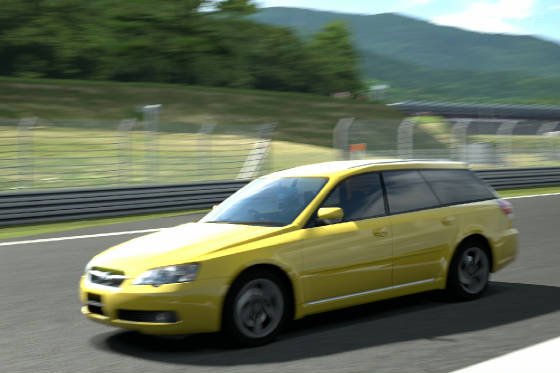
------------------------PROS-----------------------
1). Handles like a Subaru, which is akin to a warm knife going thru butter.
2). Great down-low acceleration. Overall speed is good, too, despite potential frontal drag which eventually
slows the Legacy down.
3). Gearbox is generally race-ready for many tracks.
4). So is the braking action, although earlier
games (GT and GT2) feature trail-braking which is more difficult at times.
5). This car will bite pavement, dirt, or astro-turf, and can out-manuever lower cars over bumpy areas.
6). Engine can be heavily modified via turbos, although this depends on which game you're playing and
which car you've got. Some Leg Wagons can't be modded as much.
7). Grippy, accurate steering, assuming the driver isn't going fast enough for understeer to steal
this away.
8). Racing kits for all cars in GT1 or 2.
9). Acceptable fuel-mileage (GT4). 10). Lots of visibility while using in-car view (GT5).
-------------------------CONS-------------------------
1). On the heavy side at first, and with a highish center of gravity due to the wagon's
body. Weight transfer can take some getting used to if you've been racing little coupes and hatchbacks up till now, as Touring
Wagons tend to get a bit mooshy thru some turns.
2.) Turbo lag. As typical, you'll notice it as more horses are unleashed from the barn in GT1. It'll be much
more of a concern in this first game than in later ones.
3). Brakes need balancing before some of us can afford to have them fixed up (GT and GT2, mostly). As
we drive this wagon harder and harder, it'll trail-brake from greater speeds with its grippy front-end. Great for maneuverability
if you can control it...the problem is many can't control it, and will need limited-slip deceleration help, and/or
a brake-balancer.
4). Want to go for a trip to Home Depot? There's plenty of trunk space, but uhhh...this makes it
not really suited for racing! Sway-oversteer can become a prob in certain games because of this.
5). Watch out for that understeer! Cars that haven't had weight reductions are prone to oversteer,
too, in any game except GT4.
6). Some may get turned-off by this combination between wagon and sports car. Some
find Legacys (or Subies in general) ugly as well. 7).
Difficult to find (GT5) in those used car lots.
Published: June 6, 2004
GT5 Content: January 25, 2016
|